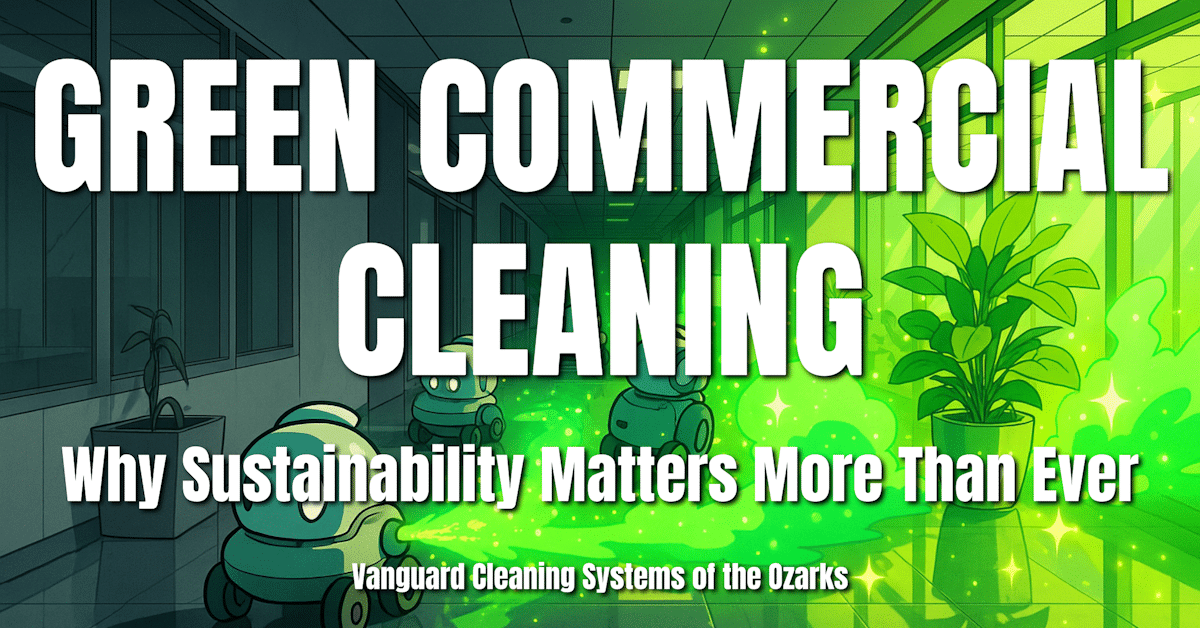Sustainable cleaning isn’t just better for the planet—it’s smarter for your business.

Why Sustainable Cleaning Is Now a Business Essential
Traditional commercial cleaning methods, once considered effective and affordable, now carry hidden costs that can no longer be ignored. From chemical-laden products to resource-heavy processes, these methods contribute to indoor air pollution, environmental degradation, and health risks for cleaning staff and building occupants alike. As awareness grows, businesses are under increasing pressure to align their operations with sustainability standards.
Green commercial cleaning has emerged as a practical response—one that prioritizes human health, environmental responsibility, and long-term efficiency without compromising on cleanliness. What was once viewed as an optional upgrade is now a baseline expectation in many industries. The shift is driven not only by ethical considerations but also by measurable benefits in performance, compliance, and consumer trust.
In this context, sustainability matters more than ever. It reflects a company’s commitment to the future, strengthens brand reputation, and supports safer, healthier environments for everyone.
Health and Safety Imperatives
Conventional cleaning products often contain harsh chemicals that release volatile organic compounds (VOCs) into the air, increasing the risk of respiratory irritation, headaches, and long-term health complications for workers and building occupants. These substances can linger in enclosed spaces, compounding their effects over time.
Green commercial cleaning methods reduce these risks by using plant-based, biodegradable ingredients that minimize toxic exposure without sacrificing effectiveness. Products are designed to break down safely after use, leaving behind fewer residues and reducing the need for aggressive rinsing or ventilation.
This shift benefits not only cleaning staff but also employees, clients, and visitors who spend extended periods indoors. Healthier air quality, fewer allergens, and lower chemical load translate to improved well-being and reduced sick days—key metrics that matter to both HR departments and facilities managers.
Microbiological Performance and Hygiene Standards
A common misconception is that green cleaning compromises hygiene. However, field studies across civil and healthcare environments show that sustainable cleaning protocols consistently meet or exceed microbial safety standards.
Eco-labeled detergents and biodegradable disinfectants have demonstrated the ability to reduce surface bacteria to acceptable levels, even in high-touch, high-risk areas. In hospitals and public buildings, green protocols achieved microbial control without relying on aggressive chemical formulations.
These results reinforce that sustainability does not mean sacrificing cleanliness. When paired with proper training and standardized procedures, green cleaning delivers reliable, repeatable hygiene outcomes across diverse commercial settings—from offices to medical facilities.
Environmental Impact and Emissions Reduction
Traditional cleaning systems contribute heavily to environmental degradation through chemical runoff, excessive energy use, and high carbon emissions. From the production of harsh detergents to wasteful laundering practices, the environmental cost adds up quickly—especially at scale.
Green commercial cleaning addresses these issues through more efficient product formulations, reduced packaging waste, and eco-conscious equipment. Life cycle assessments have shown that sustainable cleaning protocols significantly lower greenhouse gas emissions per square meter cleaned. Additionally, energy-efficient tools and optimized water usage further reduce the environmental footprint.
By adopting green practices, businesses can lower their operational impact, meet evolving regulatory requirements, and play a measurable role in climate change mitigation. Sustainability in cleaning is no longer a theoretical goal—it’s a data-supported strategy with tangible environmental returns.
Operational Efficiency and Resource Management
Green cleaning strategies are designed not only to be environmentally responsible but also to streamline daily operations. Many sustainable protocols rely on concentrated, diluted solutions that reduce product consumption and storage needs. This results in fewer shipments, less packaging waste, and lower overall costs.
Water and energy usage are also optimized through equipment that requires minimal input while maintaining performance. Microfiber technologies, for example, clean effectively with less water and fewer chemicals. Low-moisture floor machines and cold-water systems further reduce utility demands.
These efficiency gains extend to labor. With clear procedures, safer products, and ergonomic tools, staff can clean more effectively and with less physical strain. Sustainable cleaning shifts the focus from volume and frequency to precision and process, making every action count.
Organizational Performance and Culture
Sustainability initiatives often begin with policy but succeed through culture. In commercial cleaning, frontline workers play a central role in turning green strategies into daily habits. When cleaning staff are properly trained and equipped, they become active participants in sustainability—not just task performers.
Companies that prioritize green cleaning often report higher job satisfaction, reduced turnover, and stronger internal communication. This is especially true when workers are empowered with knowledge about the environmental and health impact of their tasks. Recognition of their role in protecting public health and the environment fosters a greater sense of purpose.
Management support is critical. When leadership integrates sustainability into company values and invests in ongoing training, green cleaning becomes a core operational standard rather than a side initiative. The result is a more resilient, accountable, and forward-thinking workforce.
Market Competitiveness and Consumer Perception
As sustainability becomes a key decision factor for clients, green commercial cleaning offers a distinct competitive edge. Businesses and institutions increasingly seek service providers that align with their environmental values and corporate social responsibility goals.
Eco-certifications, use of non-toxic products, and transparent green practices enhance brand credibility. Clients are more likely to trust and retain vendors who demonstrate a commitment to health, safety, and sustainability. This is especially important in industries like healthcare, education, and hospitality, where public perception and compliance are tightly linked.
Green cleaning also opens access to contracts that require environmentally responsible vendors. Government agencies, LEED-certified buildings, and eco-conscious corporations often mandate sustainable practices as part of their procurement standards. For cleaning providers, embracing green methods is not just ethical—it’s essential to staying competitive in a changing market.
Economic Value Beyond Compliance
While the initial transition to green cleaning may involve costs for training, equipment, or product changes, the long-term financial benefits are substantial. Sustainable practices reduce waste, lower energy and water bills, and minimize the need for frequent product replenishment.
Fewer workplace injuries from harsh chemical exposure and better indoor air quality can also lead to reduced insurance claims and healthcare expenses. Additionally, businesses that adopt green cleaning often experience fewer compliance violations and avoid penalties tied to environmental or safety regulations.
Beyond internal savings, sustainability adds market value. Clients are willing to pay more for services that align with their values, especially when supported by data and certification. Green cleaning becomes a revenue driver—not just a cost center—when it supports retention, differentiation, and trust in competitive markets.
Behavioral Drivers and Implementation Needs
The success of green commercial cleaning depends not just on products and protocols, but on the behaviors of those implementing them. Day-to-day cleaning practices are shaped by staff awareness, workplace culture, and management support. Without alignment at all levels, even the best green strategies can fail.
Training is essential. Cleaning staff must understand how and why to use eco-friendly products, how to sort and manage waste properly, and how their actions impact broader sustainability goals. Clear procedures, consistent communication, and access to safe, effective tools are the foundation of lasting behavior change.
Leadership must also model and reinforce sustainable values. When management prioritizes sustainability—through budgeting, recognition, and transparency—staff are more likely to take ownership. Ultimately, successful green cleaning programs are not just technical upgrades but cultural shifts built on shared responsibility and consistent follow-through.
Green Commercial Cleaning: Answers to Your Top Questions
What is green commercial cleaning?
Green commercial cleaning uses environmentally friendly products, equipment, and procedures to reduce health risks and environmental impact. It focuses on non-toxic, biodegradable ingredients and sustainable practices that maintain hygiene without harming indoor air quality or ecosystems.
Are green cleaning products as effective as traditional ones?
Yes. Green cleaning products that meet third-party certifications can match or exceed the performance of traditional cleaners. They are tested for microbial reduction, residue control, and surface safety—especially when used with standardized procedures and trained staff.
Is green cleaning more expensive?
Upfront costs may be slightly higher for some products or equipment, but long-term savings often offset this. Businesses benefit from lower energy use, reduced waste, improved worker health, and better client retention, which all contribute to cost-efficiency over time.
What certifications should I look for in green cleaning services?
Look for services that use products certified by reputable programs such as Green Seal, EPA Safer Choice, or EcoLogo. Service providers may also follow guidelines from LEED, WELL Building Standard, or ISO 14001 for environmental management.
How does green cleaning improve workplace health?
By avoiding harsh chemicals and airborne irritants, green cleaning reduces exposure to toxins that cause asthma, skin irritation, and other health problems. This leads to better indoor air quality, fewer sick days, and higher employee well-being.
Can green cleaning help with LEED or sustainability compliance?
Yes. Green cleaning contributes to earning points in sustainability certifications like LEED for Operations and Maintenance. It demonstrates environmental stewardship and supports corporate social responsibility goals.
What industries benefit most from green cleaning?
Green cleaning is especially valuable in healthcare, education, hospitality, and office environments—anywhere people spend long hours indoors. These settings benefit from reduced chemical exposure, safer surfaces, and improved air quality.
How do I transition my cleaning operations to a sustainable model?
Start by auditing your current products, waste practices, and equipment. Replace toxic cleaners with eco-certified options, train staff on new protocols, and implement waste sorting or recycling measures. Partnering with a green-certified cleaning company can streamline this transition.
References
- Fontana, R., Buratto, M., Caproni, A., Nordi, C., Pappadà, M., Bandera, B., Vogli, L., Buffone, C., & Marconi, P. (2024). Evaluating Cleaning Services in Civil Environments: Microbiological and Life Cycle Analysis Comparing Conventional and Sustainable Methods. Sustainability. https://doi.org/10.3390/su16020487
- Fontana, R., Buratto, M., Marzola, M., Trioschi, G., Bandera, B., Buffone, C., Vogli, L., & Marconi, P. (2022). An Evaluation of Hospital Cleaning Regimes—Microbiological Evaluation and LCA Analysis after Traditional and Sustainable/Green Procedures. Sustainability. https://doi.org/10.3390/su141811465
- Aron, D. (2024). Sustainability in the Cleaning World: With Tomorrow in Mind. Bulletin of the Transilvania University of Braşov. Series VII: Social Sciences • Law. https://doi.org/10.31926/but.ssl.2024.17.66.1.10
- Semlali, Y., Elrayah, M., Sabri, M., Rahma, Z., & Bengana, I. (2024). How Can Industrial SMEs Achieve Sustainability through Cleaner Production? Green Marketing’s Role as a Mediator. Sustainability. https://doi.org/10.3390/su16198629
- Karakurum, S. (2024). GREEN MARKETING PRACTICES IN THE CONTEXT OF ENVIRONMENTAL SUSTAINABILITY: A CASE STUDY OF AN ECO-FRIENDLY CLEANING FIRM. Pressacademia. https://doi.org/10.17261/pressacademia.2024.1884
- Xu, N. (2012). Lean, Mean, Green Cleaning Machine: One School District's Quest for Sustainability. https://nature.berkeley.edu/classes/es196/projects/2012final/XuN_2012.pdf
- Osagie, A. (2018). Critical success factors for sustainable green cleaning services and organisational performance. https://openscience.utm.my/items/6135761f-2cc8-4942-9e50-25577649f2c6/full
- Aydin, M., Işık, E., & Ulu, A. (2016). Emerging sustainable/green cleaning products: health and environmental risks. https://open.icm.edu.pl/items/1080b35e-c145-4a8b-a332-3a95235e1e0c
Conclusion: Why Sustainability Matters Now
Sustainability in commercial cleaning is no longer a niche concern—it’s a core business priority. As environmental pressures rise and health standards tighten, companies can no longer afford to treat green practices as optional.
Sustainable cleaning protects human health, preserves natural resources, and strengthens organizational performance. It enhances brand reputation, opens access to environmentally conscious clients, and builds a workforce that takes pride in its impact.
The shift toward green cleaning reflects a broader move toward accountability, efficiency, and long-term thinking. For businesses that want to stay relevant, responsible, and resilient, embracing sustainability in cleaning isn't just timely—it’s essential.
Vanguard Cleaning Systems of the Ozarks' franchise-owned custodial service provider business cleans more than 8M sq. ft. weekly, maintaining an industry-topping 95+% of its customer base, year-over-year, and boasting more than 60 5-star Google reviews.
Need more capability from your vendor partners? --Let's talk.
In Oklahoma, dial 918-960-4450
In Arkansas, dial 479-717-2410
In Missouri, dial 417-812-9777

